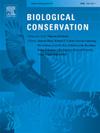地形坡度与生物多样性保护之间的关系:来自墨西哥专业鸟类的视角
IF 4.4
1区 环境科学与生态学
Q1 BIODIVERSITY CONSERVATION
引用次数: 0
摘要
对生物多样性的主要威胁是与人为活动引起的自然生态系统变化有关的威胁,如人口密度增加、农业边界扩大和城市扩张,这些活动导致对自然资源的高需求。植被覆盖的退化往往主要出现在容易进入的平坦地区,导致生物群落的动态和组成发生变化。这一转变过程导致物种的分布和丰富程度逐渐减少,特别是那些与受保护植被(即原始植被)有关的物种。在这项工作中,我们分析了墨西哥保护植被专用鸟类的潜在丰富度分布是否随着地形坡度的增加而增加,并认为它是景观转变的一个代表。我们将墨西哥土地利用覆盖度(INEGI VII)重新划分为转化覆盖度和保留覆盖度,并对每个覆盖度的坡度进行了表征。在此基础上,通过建立物种分布模型(SDMs)估算了56种陆地覆盖特种鸟的丰富度空间格局。利用空间自回归模型(spatial autoregressive models, SAR)分析了这一格局,并描述了物种在保护覆盖区内的分布。研究发现,鸟类丰富度与地形坡度呈显著正相关,表明墨西哥的陡坡是生物多样性的避难所。另一方面,我们发现,在轻度和中度坡度地区,转变模式加剧,导致某些物种的分布减少了60%至75%,这表明人类活动向较大坡度地区推进。本文章由计算机程序翻译,如有差异,请以英文原文为准。

The relationship between the terrain slope and biodiversity conservation: a perspective from the specialist avifauna of Mexico
The main threats to biodiversity are those associated with transforming natural ecosystems due to anthropogenic activities, such as increasing population density, raising the agricultural frontier, and urban expansion, which lead to a high demand for natural resources. The degradation of vegetation cover tends to appear mainly in flat areas due to ease of access, leading to changes in the dynamics and composition of biological communities. The transformation process entails gradual losses in the distribution and richness of species, particularly those associated with conserved vegetation (i.e., primary vegetation). In this work, we analyzed whether the potential richness distributions of conserved vegetation specialist bird species increase with the terrain slope in Mexico, considering it a proxy for landscape transformation. We recategorized the land-use Mexican coverages INEGI VII into transformed and conserved coverages and characterized the slope in each. Further, we estimated the spatial pattern of richness by creating species distribution models (SDMs) for 56 conserved land cover specialist birds. We analyzed this pattern using spatial autoregressive models (SAR) and described the species distribution in conserved coverages. We found a statistically significant and positive relationship between bird richness and terrain slope, suggesting that steep slopes in Mexico represent biodiversity refuges. On the other hand, we identified areas where transformation patterns have intensified in areas of slight and moderate slopes, leading to a loss of between 60 % and 75 % of the distribution of some species, evidencing an advance of anthropization toward areas of greater slope.
求助全文
通过发布文献求助,成功后即可免费获取论文全文。
去求助
来源期刊

Biological Conservation
环境科学-环境科学
CiteScore
10.20
自引率
3.40%
发文量
295
审稿时长
61 days
期刊介绍:
Biological Conservation is an international leading journal in the discipline of conservation biology. The journal publishes articles spanning a diverse range of fields that contribute to the biological, sociological, and economic dimensions of conservation and natural resource management. The primary aim of Biological Conservation is the publication of high-quality papers that advance the science and practice of conservation, or which demonstrate the application of conservation principles for natural resource management and policy. Therefore it will be of interest to a broad international readership.
 求助内容:
求助内容: 应助结果提醒方式:
应助结果提醒方式:


